
Quick Facts

Biography
Henry IV (French: Henri IV, read as Henri-Quatre pronounced: [ɑ̃ʁi.katʁ]; 13 December 1553 – 14 May 1610), also known by the epithet "Good King Henry", was King of Navarre (as Henry III) from 1572 to 1610 and King of France from 1589 to 1610. He was the first French monarch of the House of Bourbon, a branch of the Capetian dynasty.
Baptised as a Catholic but raised in the Protestant faith by his mother Jeanne d'Albret, Queen of Navarre, he inherited the throne of Navarre in 1572 on the death of his mother. As a Huguenot, Henry was involved in the French Wars of Religion, barely escaping assassination in the St. Bartholomew's Day massacre, and later led Protestant forces against the royal army.
Henry, as Head of the House of Bourbon, was a direct male-line descendant of Louis IX of France, and "first prince of the blood". Upon the death of his brother-in-law and distant cousin Henry III of France in 1589, Henry was called to the French succession by the Salic law. He initially kept the Protestant faith and had to fight against the Catholic League, which denied that he could wear France's crown as a Protestant. To obtain mastery over his kingdom, after four years of stalemate, he found it prudent to abjure the Calvinist faith. As a pragmatic politician (in the parlance of the time, a politique), he displayed an unusual religious tolerance for the era. Notably, he promulgated the Edict of Nantes (1598), which guaranteed religious liberties to Protestants, thereby effectively ending the Wars of Religion. He was assassinated in 1610 by François Ravaillac, a fanatical Catholic, and was succeeded by his son Louis XIII.
Considered a usurper by some Catholics and a traitor by some Protestants, Henry became target of at least 12 assassination attempts. An unpopular king immediately after his accession, Henry's popularity greatly improved after his death, in light of repeated victories over his enemies and his conversion to Catholicism. The "Good King Henry" (le bon roi Henri) was remembered for his geniality and his great concern about the welfare of his subjects. He was celebrated in the popular song Vive le roi Henri and in Voltaire's Henriade.
Early life
Childhood and adolescence
Henry was born in Pau, the capital of the joint Kingdom of Navarre with the sovereign principality of Béarn. His parents were Queen Joan III of Navarre (Jeanne d'Albret) and her consort, Antoine de Bourbon, Duke of Vendôme, King of Navarre. Although baptised as a Roman Catholic, Henry was raised as a Protestant by his mother, who had declared Calvinism the religion of Navarre. As a teenager, Henry joined the Huguenot forces in the French Wars of Religion. On 9 June 1572, upon his mother's death, the 19 year old became King of Navarre.

First marriage and Saint Bartholomew's Day Massacre
At Queen Joan's death, it was arranged for Henry to marry Margaret of Valois, daughter of Henry II and Catherine de' Medici. The wedding took place in Paris on 18 August 1572 on the parvis of Notre Dame Cathedral. On 24 August, the Saint Bartholomew's Day Massacre began in Paris. Several thousand Protestants who had come to Paris for Henry's wedding were killed, as well as thousands more throughout the country in the days that followed. Henry narrowly escaped death thanks to the help of his wife and his promise to convert to Catholicism. He was made to live at the court of France, but he escaped in early 1576. On 5 February of that year, he formally abjured Catholicism at Tours and rejoined the Protestant forces in the military conflict. He named his 16-year-old sister, Catherine de Bourbon, regent of Béarn. Catherine held the regency for nearly thirty years.
Wars of Religion


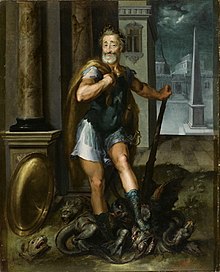
Henry became heir presumptive to the French throne in 1584 upon the death of Francis, Duke of Anjou, brother and heir to the Catholic Henry III, who had succeeded Charles IX in 1574. Because Henry of Navarre was the next senior agnatic descendant of King Louis IX, King Henry III had no choice but to recognise him as the legitimate successor. Salic law barred the king's sisters and all others who could claim descent through only the female line from inheriting. Since Henry of Navarre was a Huguenot, the issue was not considered settled in many quarters of the country and France was plunged into a phase of the Wars of Religion known as the War of the Three Henries. Henry III and Henry of Navarre were two of these Henries. The third was Henry I, Duke of Guise, who pushed for complete suppression of the Huguenots and had much support among Catholic loyalists. Political disagreements among the parties set off a series of campaigns and counter-campaigns that culminated in the Battle of Coutras. In December 1588, Henry III had Henry I of Guise murdered, along with his brother, Louis Cardinal de Guise. Henry III thought that the removal of Guise would finally restore his authority. Instead, however, the populace were horrified and rose against him. In several cities, the title of the king was no longer recognized. His power was limited to Blois, Tours and the surrounding districts. In the general chaos there was still one power on whom the king could rely — Henry of Navarre and his Huguenots.
The two kings were united by a common interest — to win France from the League. Henry III acknowledged the King of Navarre as a true subject and Frenchman, not a fanatic Huguenot aiming for the destruction of Catholics. Catholic royalist nobles also rallied to the king's standard. With this combined force the two kings marched to Paris. The morale of the city was low, and even the Spanish ambassador believed the city could not hold out longer than a fortnight. But Henry III was assassinated shortly thereafter (2 August 1589) by a fanatic monk.
When Henry III died, Henry of Navarre nominally became king of France. The Catholic League, however, strengthened by support from outside the country—especially from Spain—was strong enough to prevent a universal recognition of his new title. Most of the Catholic nobles who had joined Henry III for the siege of Paris also refused to recognize the claim of Henry of Navarre, and abandoned him. He set about winning his kingdom by military conquest, aided by English money and German troops. Henry's Catholic uncle Charles, Cardinal de Bourbon, was proclaimed king by the League, but the Cardinal was Henry's prisoner at the time. Henry was victorious at the Battle of Arques and the Battle of Ivry, but failed to take Paris after besieging it in 1590.
When Cardinal de Bourbon died in 1590, the League could not agree on a new candidate. While some supported various Guise candidates, the strongest candidate was probably the Infanta Isabella Clara Eugenia of Spain, the daughter of Philip II of Spain, whose mother Elisabeth had been the eldest daughter of Henry II of France. In the religious fervor of the time, the Infanta was recognized to be a suitable candidate, provided that she marry a suitable husband. The French overwhelmingly rejected Philip's first choice, Archduke Ernest of Austria, the Emperor's brother, also a member of the House of Habsburg. In case of such opposition, Philip indicated that princes of the House of Lorraine would also be acceptable to him: the Duke of Guise; a son of the Duke of Lorraine; and the son of the Duke of Mayenne. The Spanish ambassadors then selected the Duke of Guise, to the joy of the League. But at that moment of seeming victory the envy of the Duke of Mayenne was aroused, and he blocked the proposed election of a king.
The Parlement of Paris also upheld the Salic law. They argued that if the French accepted natural hereditary succession, as proposed by the Spaniards, and accepted a woman as their queen, then the ancient claims of the English kings would be confirmed, and the monarchy of centuries past would be nothing but an illegality. The Parlement admonished Mayenne, as Lieutenant-General, that the Kings of France had resisted the interference of the Pope in political matters, and that he should not raise a foreign prince or princess to the throne of France under the pretext of religion. Mayenne was angered that he had not been consulted prior, but yielded, since their aim was not contrary to his present views.
Despite these setbacks for the League, Henry remained unable to take control of Paris.
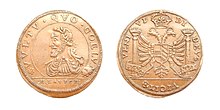

"Paris is well worth a Mass"
On 25 July 1593, with the encouragement of the great love of his life, Gabrielle d'Estrées, Henry permanently renounced Protestantism and converted to Roman Catholicism -- not based on an honest belief in Catholicism, but instead for the purpose of obtaining the French crown, thereby earning the resentment of the Huguenots and his former ally Queen Elizabeth I of England. He was said to have declared that Paris vaut bien une messe ("Paris is well worth a mass"), although there is some doubt whether he said this, or whether the statement was attributed to him by his contemporaries. His acceptance of Roman Catholicism secured the allegiance of the vast majority of his subjects. Since Reims, the traditional location for the coronation of French kings, was still occupied by the Catholic League, he was crowned King of France at the Cathedral of Chartres on 27 February 1594. He did not forget his former Calvinist coreligionists, however, and in 1598 issued the Edict of Nantes, which granted circumscribed toleration to the Huguenots.
Second marriage
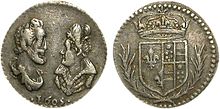
Henry's first marriage was not a happy one, and the couple remained childless. Henry and Margaret separated even before Henry acceded to the throne in August 1589, and Margaret lived for many years in the Château d'Usson in the Auvergne. After Henry became king of France, it was of the utmost importance that he provide an heir to the crown to avoid the problem of a disputed succession. Henry favoured the idea of obtaining an annulment of his marriage to Margaret and taking Gabrielle d'Estrées as his bride; after all, she had already borne him three children. Henry's councillors strongly opposed this idea, but the matter was resolved unexpectedly by Gabrielle's sudden death in the early hours of 10 April 1599, after she had given birth to a premature and stillborn son. His marriage to Margaret was annulled in 1599, and he then married Marie de' Medici in 1600.
For the royal entry of Marie into Avignon on 19 November 1600, the citizens bestowed on Henry the title of the Hercule Gaulois ("Gallic Hercules"), justifying the extravagant flattery with a genealogy that traced the origin of the House of Navarre to a nephew of Hercules' son Hispalus.
Achievements of his reign
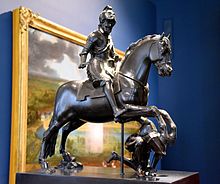
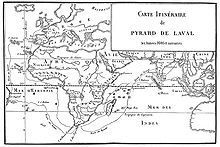
During his reign, Henry IV worked through his faithful right-hand man, the minister Maximilien de Béthune, Duke of Sully, to regularise state finance, promote agriculture, drain swamps, undertake public works, and encourage education, as with the creation of the Collège Royal Henri-le-Grand in La Flèche (today the Prytanée Militaire de la Flèche). He and Sully protected forests from further devastation, built a system of tree-lined highways, and constructed bridges and canals. He had a 1200-meter canal built in the park at the Château Fontainebleau (which may be fished today) and ordered the planting of pines, elms, and fruit trees. He used one construction project to attract attention to his power. When building the Pont-Neuf, a bridge, he placed a statue of himself in the middle.
The King restored Paris as a great city, with the Pont Neuf, which still stands today, constructed over the river Seine to connect the Right and Left Banks of the city. Henry IV also had the Place Royale built (since 1800 known as Place des Vosges), and added the Grande Galerie to the Louvre Palace. More than 400 meters long and thirty-five meters wide, this huge addition was built along the bank of the Seine River, and at the time was the longest edifice of its kind in the world. King Henry IV, a promoter of the arts by all classes of people, invited hundreds of artists and craftsmen to live and work on the building's lower floors. This tradition continued for another two hundred years, until Emperor Napoleon I banned it. The art and architecture of his reign have become known as the "Henry IV style" since that time.
King Henry's vision extended beyond France, and he financed several expeditions of Pierre Dugua, Sieur de Monts and Samuel de Champlain to North America, which saw France lay claim to Canada.
International relations under Henry IV


The reign of Henry IV saw the continuation of the rivalry among France, the Habsburg rulers of Spain, and the Holy Roman Empire for the mastery of Western Europe, a conflict that would only be resolved after the Thirty Years' War.
Spain and Italy
During Henry's struggle for the crown, Spain had been the principal backer of the Catholic League, and it tried to thwart Henry. Under the Duke of Parma, an army from the Spanish Netherlands intervened in 1590 against Henry and foiled his siege of Paris. Another Spanish army helped the nobles opposing Henry to win the Battle of Craon against his troops in 1592.
After Henry's coronation, the war continued as an official tug-of-war between the French and Spanish states, but after victory at the Siege of Amiens in September 1597 the Peace of Vervins was signed in 1598. This enabled him to turn his attention to Savoy, with which he also had been fighting. Their conflicts were settled in the Treaty of Lyon of 1601, which mandated territorial exchanges between France and the Duchy of Savoy.
Germany
In 1609 Henry's intervention helped to settle the War of the Jülich succession through diplomatic means.
It was widely believed that in 1610 Henry was preparing to go to war against the Holy Roman Empire. The preparations were terminated by his assassination, however, and the subsequent rapprochement with Spain under the regency of Marie de' Medici.
Ottoman Empire

Even before Henry's accession to the French throne, the French Huguenots were in contact with Aragonese Moriscos in plans against the Habsburg government of Spain in the 1570s. Around 1575, plans were made for a combined attack of Aragonese Moriscos and Huguenots from Béarn under Henry against Spanish Aragon, in agreement with the king of Algiers and the Ottoman Empire, but this project floundered with the arrival of John of Austria in Aragon and the disarmament of the Moriscos. In 1576, a three-pronged fleet from Constantinople was planned to disembark between Murcia and Valencia while the French Huguenots would invade from the north and the Moriscos accomplish their uprising, but the Ottoman fleet failed to arrive. After his crowning, Henry continued the policy of a Franco-Ottoman alliance and received an embassy from Sultan Mehmed III in 1601. In 1604, a "Peace Treaty and Capitulation" was signed between Henry IV and the Ottoman Sultan Ahmet I. It granted numerous advantages to France in the Ottoman Empire.
In 1606–7, Henry IV sent Arnoult de Lisle as Ambassador to Morocco to obtain the observance of past friendship treaties. An embassy was sent to Tunisia in 1608 led by François Savary de Brèves.
East Asia
During the reign of Henry IV, various enterprises were set up to develop trade with faraway lands. In December 1600, a company was formed through the association of Saint-Malo, Laval, and Vitré to trade with the Moluccas and Japan. Two ships, the Croissant and the Corbin, were sent around the Cape of Good Hope in May 1601. One was wrecked in the Maldives, leading to the adventure of François Pyrard de Laval, who managed to return to France in 1611. The second ship, carrying François Martin de Vitré, reached Ceylon and traded with Aceh in Sumatra, but was captured by the Dutch on the return leg at Cape Finisterre. François Martin de Vitré was the first Frenchman to write an account of travels to the Far East in 1604, at the request of Henry IV, and from that time numerous accounts on Asia would be published.
From 1604 to 1609, following the return of François Martin de Vitré, Henry developed a strong enthusiasm for travel to Asia and attempted to set up a French East India Company on the model of England and the Netherlands. On 1 June 1604, he issued letters patent to Dieppe merchants to form the Dieppe Company, giving them exclusive rights to Asian trade for 15 years. No ships were sent, however, until 1616. In 1609, another adventurer, Pierre-Olivier Malherbe, returned from a circumnavigation of the globe and informed Henry of his adventures. He had visited China and India, and had an encounter with Akbar.
Character

Henry IV proved to be a man of vision and courage. Instead of waging costly wars to suppress opposing nobles, Henry simply paid them off. As king, he adopted policies and undertook projects to improve the lives of all subjects, which made him one of the country's most popular rulers ever.
Henry is said to have originated the oft-repeated phrase, "a chicken in every pot". The context for that phrase:
Si Dieu me prête vie, je ferai qu'il n'y aura point de laboureur en mon royaume qui n'ait les moyens d'avoir le dimanche une poule dans son pot!
(If God keeps me, I will make sure that no peasant in my realm will lack the means to have a chicken in the pot on Sunday!)
This statement epitomises the peace and relative prosperity which Henry brought to France after decades of religious war, and demonstrates how well he understood the plight of the French worker and peasant farmer. This real concern for the living conditions of the "lowly" population – who in the final analysis provided the economic basis for the power of the king and the great nobles – was perhaps without parallel among the kings of France. Following his death Henry would be remembered fondly by most of the population.
Henry's forthright manner, physical courage, and military successes also contrasted dramatically with the sickly, effete languor of the last Valois kings, as evinced by his blunt assertion that he ruled with "weapon in hand and arse in the saddle" (on a le bras armé et le cul sur la selle). He was also a great philanderer, fathering many children by a number of mistresses.
Nicknames
Henry was nicknamed "the Great" (Henri le Grand), and in France is also called le bon roi Henri ("the good king Henry") or le vert galant ("The Green Gallant", for his numerous mistresses).
In English he is most often referred to as Henry of Navarre.
Assassination
Henry was the subject of attempts on his life by Pierre Barrière in August 1593 and Jean Châtel in December 1594.
In the third assassination attempt, King Henry IV was killed in Paris on 14 May 1610 by a Catholic fanatic, François Ravaillac, who stabbed him in the Rue de la Ferronnerie. Henry's coach was stopped by traffic congestion related to the Queen's coronation ceremony, as depicted in the engraving by Gaspar Bouttats. Hercule de Rohan, duc de Montbazon, was with him when he was killed; Montbazon was wounded, but survived. Henry was buried at the Saint Denis Basilica.
His widow, Marie de' Medici, served as regent for their nine-year-old son, Louis XIII, until 1617.
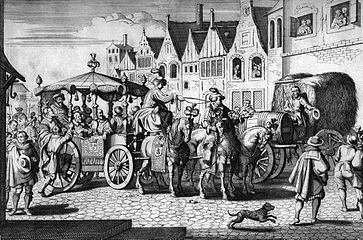
Assassination of Henry IV,
engraving by Gaspar Bouttats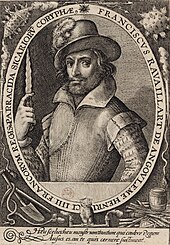
His assassin, François Ravaillac, brandishing his dagger

Lying in state at the Louvre, engraving after François Quesnel

Alleged skull of Henry IV in 1933; his tomb was ransacked during the French Revolution
Legacy
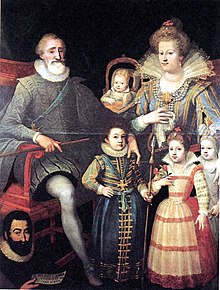
The reign of Henry IV had a lasting impact on the French people for generations afterward. A statue was erected in his honour at the Pont Neuf in 1614, four years after his death. Although this statue—as well as those of all the other French kings—was torn down during the French Revolution, it was the first to be rebuilt, in 1818, and it stands today on the Pont Neuf. A cult surrounding the personality of Henry IV emerged during the Bourbon Restoration. The restored Bourbons were keen to play down the controversial reigns of Louis XV and Louis XVI and instead emphasised the reign of the benevolent Henry IV. The song Marche Henri IV ("Long Live Henry IV") was popular during the Restoration. In addition, when Princess Caroline of Naples and Sicily (a descendant of his) gave birth to a male heir to the throne of France seven months after the assassination of her husband Charles Ferdinand, Duke of Berry, by a Republican fanatic, the boy was conspicuously named Henri in reference to his forefather Henry IV. The boy also was baptised in the traditional way of Béarn/Navarre, with a spoon of Jurançon wine and some garlic, imitating the manner in which Henry IV had been baptised in Pau. That custom had been abandoned by later Bourbon kings.
Henry IV's popularity continued when the first edition of his biography, Histoire du Roy Henry le Grand, was published in Amsterdam in 1661. It was written by Hardouin de Péréfixe de Beaumont, successively bishop of Rhodez and archbishop of Paris, primarily for the edification of Louis XIV, grandson of Henry IV. A translation into English was made by James Dauncey for another grandson, King Charles II of England. An English edition was derived from this, which was published at London in 1663.
Henry served as the loose inspiration behind Ferdinand, the King of Navarre in William Shakespeare's Love's Labour's Lost.

Genealogy
Ancestors
| Ancestors of Henry IV of France | ||||||||||||||||||||||||||||||||||||||||||||||||||||||||||||||||||||||||||||||||||||||||||||||||||||||||||||||||||||||||||||||||||||||||||||||||||||||||||||||||||||||||||||||||||||||||||||||||||||||||||||||||||||||||||||||||||||||||||||||||||||||||||||||||||||||||||||||||||||||||||||||||||||||||||||||||||||||||||||||||||||||||||||||||||||||||||||||||||||||||||||||||||||||||||||||||||||||||||||||||||||||||||||||||||||||||||||||||||||||||||||||||||||||||||||||||||||||||||||||||||||||||||||||||||||||||||||||||||||||||||||||||||||||||||||||||||
|---|---|---|---|---|---|---|---|---|---|---|---|---|---|---|---|---|---|---|---|---|---|---|---|---|---|---|---|---|---|---|---|---|---|---|---|---|---|---|---|---|---|---|---|---|---|---|---|---|---|---|---|---|---|---|---|---|---|---|---|---|---|---|---|---|---|---|---|---|---|---|---|---|---|---|---|---|---|---|---|---|---|---|---|---|---|---|---|---|---|---|---|---|---|---|---|---|---|---|---|---|---|---|---|---|---|---|---|---|---|---|---|---|---|---|---|---|---|---|---|---|---|---|---|---|---|---|---|---|---|---|---|---|---|---|---|---|---|---|---|---|---|---|---|---|---|---|---|---|---|---|---|---|---|---|---|---|---|---|---|---|---|---|---|---|---|---|---|---|---|---|---|---|---|---|---|---|---|---|---|---|---|---|---|---|---|---|---|---|---|---|---|---|---|---|---|---|---|---|---|---|---|---|---|---|---|---|---|---|---|---|---|---|---|---|---|---|---|---|---|---|---|---|---|---|---|---|---|---|---|---|---|---|---|---|---|---|---|---|---|---|---|---|---|---|---|---|---|---|---|---|---|---|---|---|---|---|---|---|---|---|---|---|---|---|---|---|---|---|---|---|---|---|---|---|---|---|---|---|---|---|---|---|---|---|---|---|---|---|---|---|---|---|---|---|---|---|---|---|---|---|---|---|---|---|---|---|---|---|---|---|---|---|---|---|---|---|---|---|---|---|---|---|---|---|---|---|---|---|---|---|---|---|---|---|---|---|---|---|---|---|---|---|---|---|---|---|---|---|---|---|---|---|---|---|---|---|---|---|---|---|---|---|---|---|---|---|---|---|---|---|---|---|---|---|---|---|---|---|---|---|---|---|---|---|---|---|---|---|---|---|---|---|---|---|---|---|---|---|---|---|---|---|---|---|---|---|---|---|---|---|---|---|---|---|---|---|---|---|---|---|---|---|---|---|---|---|---|---|---|---|---|---|---|---|---|---|---|---|---|---|---|---|---|---|---|---|---|---|---|---|---|---|---|---|---|---|---|---|---|---|---|---|---|---|---|---|---|---|---|---|---|---|---|---|---|---|---|---|---|---|---|---|---|---|---|---|---|---|---|---|---|---|---|---|---|---|---|---|---|---|---|---|---|---|---|---|---|---|---|---|---|---|---|---|---|---|---|---|---|---|---|---|---|---|---|---|---|---|---|---|---|---|---|---|---|---|---|---|---|---|---|---|---|---|---|---|
| ||||||||||||||||||||||||||||||||||||||||||||||||||||||||||||||||||||||||||||||||||||||||||||||||||||||||||||||||||||||||||||||||||||||||||||||||||||||||||||||||||||||||||||||||||||||||||||||||||||||||||||||||||||||||||||||||||||||||||||||||||||||||||||||||||||||||||||||||||||||||||||||||||||||||||||||||||||||||||||||||||||||||||||||||||||||||||||||||||||||||||||||||||||||||||||||||||||||||||||||||||||||||||||||||||||||||||||||||||||||||||||||||||||||||||||||||||||||||||||||||||||||||||||||||||||||||||||||||||||||||||||||||||||||||||||||||||
Patrilineal descent
| Patrilineal descent |
|---|
Henry's patriline was his line of descent in the male line, that is, from father to son only. Patrilineal descent governs membership and succession in many royal and noble houses. Henry was a scion of the House of Bourbon, which was a branch of the Capetian dynasty, which sprang from the Robertians. Henry's patriline ran through the house of Bourbon-Vendôme (Counts and then Dukes of Vendôme), descended from a younger son of the Count of Marche, descended from a younger son of the Duke of Bourbon, whose father was a younger son of Louis IX. Louis was the direct descendant of Hugh Capet, who became King of France in 987 and made the crown hereditary. Hugh was the heir of the "Robertian" house, Counts of Worms, descended from Robert of Hesbaye. This line has continued to the present day, more than 1,200 years in all, through kings of France, Navarre, France again, Spain, Portugal, and the Two Sicilies, dukes of Parma, grand dukes of Luxembourg, princes of Orléans, and emperors of Brazil. It is one of the oldest royal patrilines in Europe.
|
Religion
Henry IV was baptized a Roman Catholic on January 5, 1554. He was raised Reformed by his mother Jeanne III of Navarre. In 1572, after the massacre of French Calvinists, he was forced by Catherine de' Medici and other powerful Roman Catholic royalty to convert. In 1576, as he managed to escape from Paris, he abjured Roman Catholicism and returned to Calvinism. In 1593, in order to become King of France rather than by his own beliefs, he converted again to Roman Catholicism. Although a formal Roman Catholic, he valued his Calvinist upbringing and was tolerant toward the Huguenots until his death in 1610, and issued the Edict of Nantes which granted many concessions to them.
Henry's religious affiliation by date:
None (1553; not baptized yet)
Roman Catholic (1554; at baptism)
Reformed (1554-1572; raised Calvinist)
Roman Catholic (1572-1576; forced conversion to Roman Catholicism)
Reformed (1576-1593; returned to Calvinism)
Roman Catholic (1593-1610; converted to Roman Catholicism for coronation)
Marriages and legitimate children
On 18 August 1572, Henry married his second cousin Margaret of Valois; their childless marriage was annulled in 1599. His subsequent marriage to Marie de' Medici on 17 December 1600 produced six children:
| Name | Birth | Death | Notes |
|---|---|---|---|
| Louis XIII, King of France | 27 September 1601 | 14 May 1643 | Married Anne of Austria in 1615 |
| Elisabeth, Queen of Spain | 22 November 1602 | 6 October 1644 | Married Philip IV, King of Spain, in 1615 |
| Christine Marie, Duchess of Savoy | 10 February 1606 | 27 December 1663 | Married Victor Amadeus I, Duke of Savoy, in 1619 |
| Nicolas Henri, Duke of Orléans | 16 April 1607 | 17 November 1611 | |
| Gaston, Duke of Orléans | 25 April 1608 | 2 February 1660 | Married (1) Marie de Bourbon, Duchess of Montpensier, in 1626 Married (2) Marguerite of Lorraine in 1632 |
| Henrietta Maria, Queen of England, Queen of Scots, and Queen of Ireland | 25 November 1609 | 10 September 1669 | Married Charles I, King of England, King of Scots and King of Ireland, in 1625 |
Armorial
The arms of Henry IV changed throughout his lifetime:
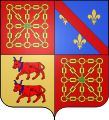
From 1562,
as Prince of Béarn and Duke of Vendôme
From 1572,
as King of Navarre
From 1589,
as King of France and Navarre<also used by his successors>
Grand Royal Coat of Arms of Henry and the House of Bourbon as Kings of France and Navarre (1589-1789)

 Sagittarius
Sagittarius






